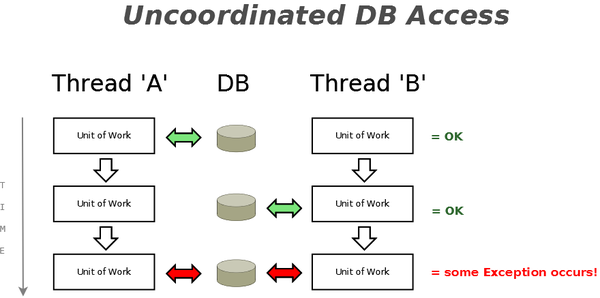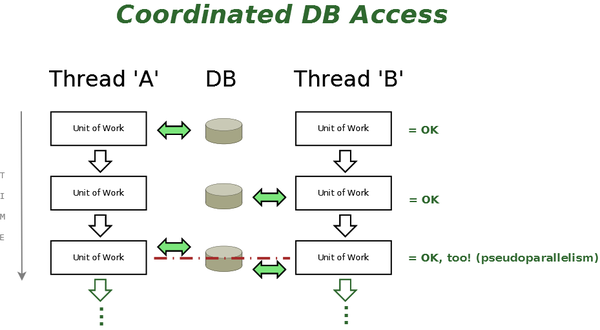Co-ordinated DB Access (Thread-safe DB Access)
THIS PAGE IS WORK IN PROGRESS
This page is currently being worked on. Please come back later to this page when you have been notified that it is finished!
Co-ordinated DB Access: Overview
The Problem it Solves
Before we had Co-ordinated DB Access in place, users ran into various Exceptions when multi-threaded DB access occurred - no matter whether that multi-threaded DB access was done intentionally/deliberately by the programmer, or whether it happened as something that resulted 'accidentally' because of an action the user took (and which we didn't prevent from happening). Co-ordinated DB Access not only prevents that from happening, but also provides new options to safely run program code that attempts to access the DB in parallel (however, multi-threading always brings some challenges, esp. with DB access - for details read the Challenges section).
The Solution
The primary solution was to make the TDataBase Class (OpenPetra's Database Access and Abstraction Layer) thread-safe (this got addressed by solving Bug #3852), meaning that we are employing pseudoparallel execution to prevent any 'collisions' on DB Access. That in itself prevented the Exceptions mentioned earlier from happening!
Building on that, ...
- provisions have been put in place to allow the OpenPetra software engineers to react programmatically to various new situations where the now co-ordinated DB Access can raise specific Typed Exceptions in case the desired 'parallel-ity' cannot be achieved automatically in a given situation;
- provisions have been made in the client-side 'Unhandled Exception Handler' to automatically show 'friendly and helpful' messages to the user when the software engineers didn't react programmatically to various new situations (yet).
The automatic 'friendly and helpful' messages may well be enough for situations in which concurrent DB access operations aren't occurring often and where the user wouldn't be too annoyed to perform any retry attempts by themselves.
The ability to react programmatically to the various new situations exists to perform automatic retries 'under the hood', to allow for 'better' provisions for the user (e.g. to provide Retry/Cancel options), and to be able to prevent the user from taking certain actions in the first place that could (later) lead to the inability to take certain actions (e.g. disallowing the opening of a screen under certain circumstances because the particular circumstance would mean that any entered data might not be 'save-able' by the user later on).
Pseudoparallel Execution
What happens in our 'co-ordinated DB Access' is that we allow only one thread at any given time access to DB-related functionality that is exposed through the TDataBase Class. That means that other threads need to wait until the first thread has finished accessing the DB through the TDataBase Class (an automatic time-out time-out is in place to mitigate 'stalling' situations).
We need to do this because we can't offer 'true' parallelism. The reasons for that are:
- The ADO.NET DB driver model cannot maintain multiple active statements (commands) on a single DB Connection.
- (Well, for SQLServer and Oracle there is a specific solution {'Multiple Active Result Sets', | MARS}, but it isn't a standard feature of ADO.NET and not available for other RDBMS's).
- even the PostgreSQL RDBMS allows only one running DB Transaction per DB Connection!
Details of the Implementation
What is Done Automatically And What Needs to be Handled Manually
Automatic (and Fully Transparent): Thread-safe DB Access through the TDataBase Class
Automatic Thread-Safety
The thread-safety is fully transparent to the software engineers, that is, the software engineers don't need to do anything to make sure it works, and don't even need to know how it works.
(For the curious: Thread-safety is achieved by using a SemaphoreSlim Object {FCoordinatedDBAccess} with a capacity of only one, two new Methods {WaitForCoordinatedDBAccess and ReleaseCoordinatedDBAccess}, and by calling those two Methods appropriately in all places where it is required to achieve thread-safety across everything the TDataBase Class can do. For the even-more-curious: A Mutex or lock couldn't be used to achieve that since these aren't 'thread-agnostic', whereas a SemaphoreSlim is thread-agnostic. Also, a SemaphoreSlim is a very performant way to achieve thread-safety. {|Details})
Automatic Time-out (Thread Stalling Prevention)
Suppose a thread that 'locks' the TDataBase Class (due to the thread-safety being in place) would run for a long time, or even 'stall' for some reason or the other, or get into an 'endless loop', and hence wouldn't release the 'lock' on the TDataBase Class. While none of these should happen (of course...), the consequence of any of this happening would be that all other threads of a user that were waiting for DB Access would be waiting to get access to the DB - for however long it takes for the first thread that 'grabbed the lock' to finish. This situation would not only give the user the impression that 'OpenPetra isn't responding/has crashed', but would also mean they couldn't save any work that they haven't saved yet, which they might be able to do if we are able to offer them 'Retry/Cancel' options. An automatic time-out is in place to help avoid those unwanted issues. This time-out applies not to the first thread (that 'locked' the TDataBase Class ), but to any 'next' thread that wants to use the TDataBase Class and which has to wait. The time-out means that this waiting isn't 'indefinite', but ends after a set time-out, and hence the thread that ran into the time-out can perform some action. That action could be as simple as repeating the request for DB access or giving the user the opportunity to either continue waiting or cancel the operation that the user initiated.
Important: The time-out doesn't mean that a thread that wants to execute some action using the TDataBase Class has to wait until the automatic time-out has expired if another thread 'grabbed the lock' earlier. Rather, the second thread will execute the action as soon as the first thread finishes its work and 'releases the lock'! Example: If the first thread 'grabs the lock', executes an action and 'releases the lock' within 4 seconds, a second (waiting) thread will be able to 'grab the lock' after those 4 seconds, and not just after the time-out expired!
When the time-out does expire, the TDataBase Class throws a new Exception, EDBCoordinatedDBAccessWaitingTimeExceededException. Though a calling Method could catch this Exception specifically, it is more helpful to catch its Base Class, EDBAccessLackingCoordinationException. For details about this see section XXXXXX.
Configuration (Optional): Automatic Time-out
The automatic time-out time can be configured. That configuration option has been introduced to prevent users from running into time-outs too often in situations where an OpenPetra Site has got a slower server than average OpenPetra Sites, or a higher concurrent user count than average OpenPetra Sites, or both. The value would be set to a higher number than the default in such situations.
The time-out value defaults to 3000 (=3.000 milliseconds, which equals 3 seconds) but can be changed by including the appSetting Server.DBWaitingTimeForCoordinatedDBAccess in the Server.config file. Testing has so far shown that 3.000 milliseconds is sufficient for situations where a 'not-very-fast' virtual test server is used on which limited numbers of users perform concurrent actions. That default could easily be changed in the future, should that become necessary (it is specified in the TDataBase Class Constructor).
Semi-Automatic: (DB-)Call Retries
The most common reaction to an automatic time-out should be a retry of getting the 'lock' on the TDataBase Class. The reason for that is that often the second or third attempt of getting this 'lock' succeeds (as many DB queries run only for a short time)! It would therefore not be very user-friendly to show a message to the user that the action that (s)he has taken could not be performed when an internal retry (which the user doesn't notice) can often succeed.
A new Class has been introduced to make it easy to program such DB call retries. The new Ict.Common.DB.TServerBusyHelper Class has got only one static Method, CoordinatedAutoRetryCall. Use this Method wherever you expect that the taking-out of a 'lock' on TDataBase could time out as other things that run in parallel might have come first in taking a 'lock' out. For details about this see section XXXXXX.
Configuration (Optional): Number of Retries
The number of retries that the CoordinatedAutoRetryCall Method automatically performs can be configured. That configuration option has been introduced to prevent users from running into time-outs too often in situations where an OpenPetra Site has got a slower server than average OpenPetra Sites, or a higher concurrent user count than average OpenPetra Sites, or both. The value would be set to a higher number than the default in such situations.
The time-out value defaults to 3 (=3 retries) but can be changed by including the appSetting CoordinatedAutoRetryCallMaxRetries in the Client.config file (for controlling the number of retries when the CoordinatedAutoRetryCall Method is used client-side) and/or the Server.config file (for controlling the number of retries when the CoordinatedAutoRetryCall Method is used server-side).
Automatic: Exception Handling in Case of Timeout
TODO
Examples
TODO
Manual: Exception Handling in Case of Timeout
TODO
Examples / Implementations
TODO
Challenges
TODO
The Future: A Safe-to-use, Multi-threading Enabled OpenPetra
TODO

